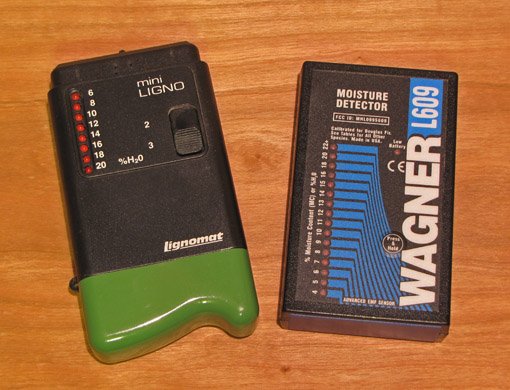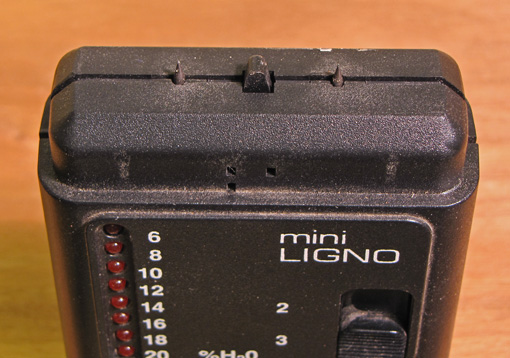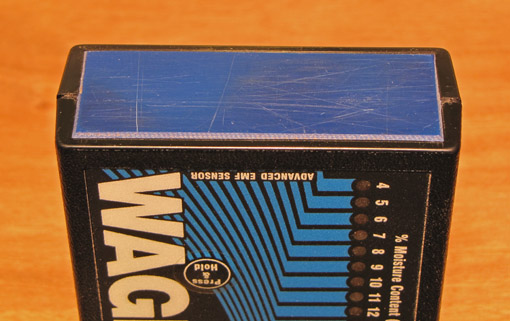
The relationship between wood and water is of great concern to woodworkers. Specifically, we want to know how much water is in the wood, and what will happen to the wood when that amount changes, as we know it always will. A moisture meter tells us the percent moisture content of wood relative to its completely dry weight.
So, we all need a moisture meter, right? Well, on the one hand, great furniture was made for hundreds of years without moisture meters. On the other hand, a meter is a modern convenience that facilitates reliable management and use of valuable wood. I use mine regularly in the shop and when I buy wood at the lumberyard.
However, to be of value, a moisture meter must be used intelligently. That is the topic here, geared for the small shop woodworker. Reviews of specific brands and models can be found in the magazines, whose publishers have the wherewithal to do such testing.
There are four keys to making effective use of a moisture meter:
1. Understand how the meters work.
2. Take the readings properly.
3. Understand the main factors that affect the readings.
4. Interpret the information and use it. You are craftsman, not a data collector.
1. How they work

“Pin” meters involve sticking two pins, from 3/16″ to 2″, into the wood. The meter works by conducting a small electric current through the wood from one pin to the other. The water in the wood conducts electricity well but the wood resists electrical flow. The meter measures the resistance, and from this, figures out how much moisture is in the wood.
It is important to realize that the meter measures the path of least electrical resistance between the pins. This means the wettest wood layer that is anywhere between the two pins. (The exception to this is the use of insulated pins that have metal exposed only at their tips.)

“Pinless” meters involve simply placing the base of the meter on the wood (no punctures). The meter produces an electromagnetic field in a three-dimensional volume of wood, defined by the functional base area of the meter and the depth to which the meter is designed to operate. The field is altered by the moisture content and density of the wood, and the meter uses that alteration to figure out how much moisture is in the wood.
It is important to realize that the meter is reading an approximately average moisture content throughout that volume of wood.
Later we’ll look at how the operating characteristics of the two types of meters affect the interpretation and use of their readings.
– – – – – – – –
Before moving on in the upcoming posts about the next three points listed above, a couple of no-tech maneuvers deserve mention.
First, when at the lumberyard, you can estimate the moisture content simply by holding your hand on the wood surface. Use this as a relative measure for boards of the same species with similar surface quality (rough or planed) in the same storage environment. The wetter wood will feel slightly cooler and damper. It is a subtle sensation, but you can use your pinless moisture meter (or borrow one) to calibrate your senses. It can be done, and it’s quick and cheap.
I’ve heard of using your lips on the wood instead of your hand to increase the sensitivity. Now, as much as I love wood . . . nah, I don’t think so.
Second, if you buy wood and want to let it reach its equilibrium moisture content for the humidity level of your shop, you can probably do well enough by simply being patient. Feel the wood right after you buy it, compare it to boards of the same species that have resided in your shop for a long time, and wait it out for a few weeks, depending on the thickness of the stock. You can also resaw a small chunk and feel the inside surfaces, and watch its movement later.
If you wait long enough, the wood is going to be OK. But how long? Well, that is why it pays to have a moisture meter – efficiency, ease, and reliability.
Next: part 2.


How many times have I been on the verge of purchasing one of these devices?
Two things have held me back: not understanding how to effectively use them (which you are now covering!) and the fact that I’ve worked for 30 plus years without one.
Delving now into areas of very fine tolerances in my work I am noticing some surprises with the shrinkage of sheet materials. A meter may be a worthy investment.
I’m glad you’re doing this series, I look forward to the next part.
I’ve gotten by so far by taking care to best figure out how the wood I’m working will move in the context of a project – but it’s very hard sometimes when the grain is a bit on the wild side. It’s doable however when things are fixed. Riven wood is great for this – the act of riving really gives you more of an idea of how the grain works out in a piece, and having pieces with the straightest possible grain and working within the contexts of how it’s apt to move is how you can build some of the traditional projects like Follansbee out of wet wood and still have it hold together years later. But that’s not the material that’s easy at hand or conducive to the pieces I want to build.
It’s hard to plunk the change on a meter when I know that money could be a new tool or some nice lumber, but hopefully after learning some more I’ll be able to better justify the cost, save myself some anxiety and heartbreak, and open up some new possibilities in design by being able account for movement better.